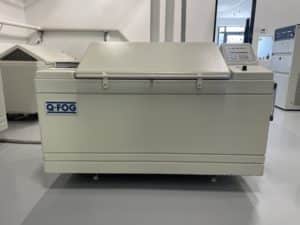ISO 11997-1
Paints and varnishes — Determination of resistance to cyclic corrosion conditions — Part 1: Wet (salt fog)/dry/humidity

Characterization of the resistance to cyclic corrosion conditions of coatings—use and factors to be considered:
The goal of ISO 11997-1 is to determine the resistance of coatings that are exposed to corrosive conditions through the use of a corrosive cyclic test. The latter consists of exposing the sample to a structured cycle that comprises a salt spray application, a wet stage and a dry stage as a means to replicate, on an accelerated basis, an exposure to a corrosive environment. More specifically, the wet and dry stages of the cycle reproduce the natural cyclic conditions of an outdoor exposure while the salt spray application stresses the coating as a means to investigate its performance towards a corrosive environment. Also, it is important to mention that it is necessary to rely on another test protocol in order to appraise the attributes of the scribe specimen due to the fact that this method does not provide acceptance criteria nor a procedure to assess the sample. Lastly, this standard does not provide a correlation that can be used to foresee the performance of the specimen onto the field, but it may serve as a comparative tool to measure the relative performance of several coatings.
The main factors that are in play when conducting this test protocol are: the thickness of the coating, the conditioning of the samples and the preparation and coating of the panels.
Typical experimental parameters for ISO 11997-1:
The number of samples required is two and it is recommended to test them concurrently with a material of known performance, so that the latter one can be used as a control. The dimensions of the specimen are 100 by 70 by 0.3 mm. Table 1 lists the parameters of each test cycle, however, the specifics of each cycle are detailed in the present practice.
Table I: Characteristics of each test cycle
| Parameters | Cycle A | Cycle B | Cycle C | Cycle D |
| Constituents of the test cycle | 1. Salt spray stage 2. Dry stage 3. Wet stage | 1. Salt fog stage 2. 100 % RH stage 3. (50 ± 20) % RH stage | 1. Salt fog stage 2. Dry stage 3. (75 ± 15) % RH stage 4. 95 to 100% RH stage | 1. Salt spray stage 2. Wet stage 3. Hot dry stage 4. Warm dry stage |
| Duration of the test cycle | 240 h (30 cycles), 480 h (60 cycles), 720 h (90 cycles) or 1440 h (180 cycles) | 840 h | 1000 h | 168 h (28 cycles) |
| pH | Between 6.0 and 7.0 | Between 6.0 and 7.0 | Between 6.0 and 7.0 | Between 6.0 and 7.0 |
| Spray solution constitution | 50 ± 10 g/L of NaCl | 50 ± 10 g/L of NaCl | 0.31 ± 0.01 g/L of NaCl with 4.1 ± 0.01 g/L of (NH4)2SO4 | 50 ± 10 g/L of NaCl |
For additional related test methods, please see cyclic corrosion testing.

